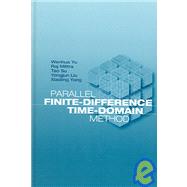
What is included with this book?
| Preface | ix | ||||
| Chapter 1 FDTD Method | 1 | (14) | |||
|
1 | (2) | |||
|
3 | (5) | |||
|
8 | (2) | |||
|
10 | (1) | |||
|
11 | (2) | |||
|
13 | (2) | |||
| Chapter 2 Boundary Conditions | 15 | (18) | |||
|
16 | (2) | |||
|
18 | (3) | |||
|
21 | (5) | |||
|
26 | (1) | |||
|
27 | (5) | |||
|
32 | (1) | |||
| Chapter 3 Improvement of the FDTD | 33 | (36) | |||
|
33 | (7) | |||
|
40 | (2) | |||
|
42 | (11) | |||
|
43 | (4) | |||
|
47 | (2) | |||
|
49 | (4) | |||
|
53 | (7) | |||
|
53 | (5) | |||
|
58 | (1) | |||
|
59 | (1) | |||
|
60 | (7) | |||
|
67 | (2) | |||
| Chapter 4 Excitation Source | 69 | (28) | |||
|
69 | (2) | |||
|
71 | (2) | |||
|
73 | (5) | |||
|
78 | (9) | |||
|
87 | (2) | |||
|
89 | (1) | |||
|
90 | (5) | |||
|
95 | (2) | |||
| Chapter 5 Data Collection and Post-Processing | 97 | (22) | |||
|
97 | (3) | |||
|
100 | (3) | |||
|
103 | (3) | |||
|
106 | (11) | |||
|
106 | (3) | |||
|
109 | (4) | |||
|
113 | (4) | |||
|
117 | (2) | |||
| Chapter 6 Introduction to Parallel Computing Systems | 119 | (26) | |||
|
120 | (5) | |||
|
121 | (1) | |||
|
122 | (1) | |||
|
123 | (1) | |||
|
124 | (1) | |||
|
125 | (1) | |||
|
126 | (4) | |||
|
130 | (5) | |||
|
135 | (8) | |||
|
143 | (2) | |||
| Chapter 7 Parallel FDTD Method | 145 | (34) | |||
|
146 | (1) | |||
|
147 | (3) | |||
|
150 | (2) | |||
|
152 | (13) | |||
|
156 | (6) | |||
|
162 | (1) | |||
|
163 | (2) | |||
|
165 | (5) | |||
|
165 | (1) | |||
|
166 | (1) | |||
|
167 | (1) | |||
|
167 | (3) | |||
|
170 | (4) | |||
|
170 | (3) | |||
|
173 | (1) | |||
|
173 | (1) | |||
|
174 | (4) | |||
|
175 | (1) | |||
|
175 | (1) | |||
|
176 | (2) | |||
|
178 | (1) | |||
| Chapter 8 Illustrative Engineering Applications | 179 | (14) | |||
|
179 | (6) | |||
|
185 | (7) | |||
|
192 | (1) | |||
| Chapter 9 FDTD Analysis of Bodies of Revolution | 193 | (22) | |||
|
193 | (1) | |||
|
194 | (4) | |||
|
198 | (2) | |||
|
200 | (7) | |||
|
207 | (1) | |||
|
208 | (5) | |||
|
209 | (1) | |||
|
210 | (3) | |||
|
213 | (2) | |||
| Chapter 10 Parallel BORJFDTD | 215 | (14) | |||
|
215 | (1) | |||
|
216 | (4) | |||
|
220 | (2) | |||
|
222 | (6) | |||
|
222 | (2) | |||
|
224 | (2) | |||
|
226 | (2) | |||
|
228 | (1) | |||
| Appendix A Introduction to Basic MPI Functions | 229 | (16) | |||
|
229 | (7) | |||
|
236 | (5) | |||
|
241 | (1) | |||
|
242 | (1) | |||
|
243 | (1) | |||
|
243 | (1) | |||
|
243 | (1) | |||
|
244 | (1) | |||
| Appendix B PC Cluster-Building Techniques | 245 | (12) | |||
|
245 | (8) | |||
|
246 | (1) | |||
|
246 | (2) | |||
|
248 | (3) | |||
|
251 | (1) | |||
|
252 | (1) | |||
|
253 | (1) | |||
|
253 | (1) | |||
|
254 | (1) | |||
|
254 | (1) | |||
|
254 | (2) | |||
|
256 | (1) | |||
| List of Notations | 257 | (2) | |||
| About the Authors | 259 | (2) | |||
| Index | 261 |
The New copy of this book will include any supplemental materials advertised. Please check the title of the book to determine if it should include any access cards, study guides, lab manuals, CDs, etc.
The Used, Rental and eBook copies of this book are not guaranteed to include any supplemental materials. Typically, only the book itself is included. This is true even if the title states it includes any access cards, study guides, lab manuals, CDs, etc.